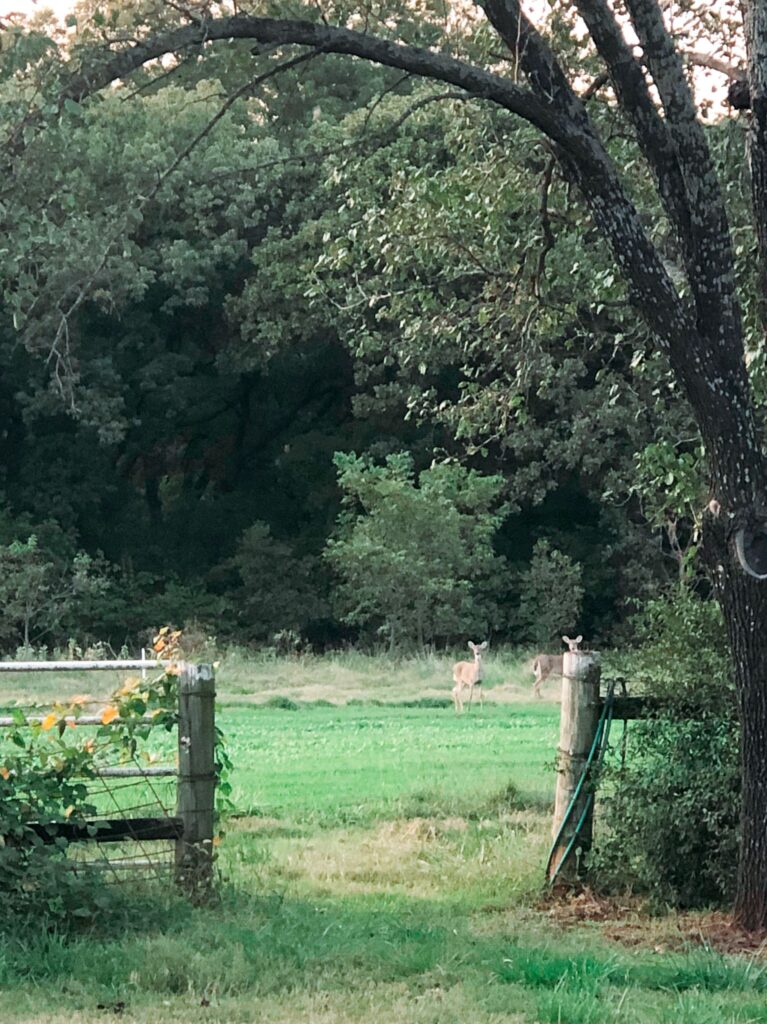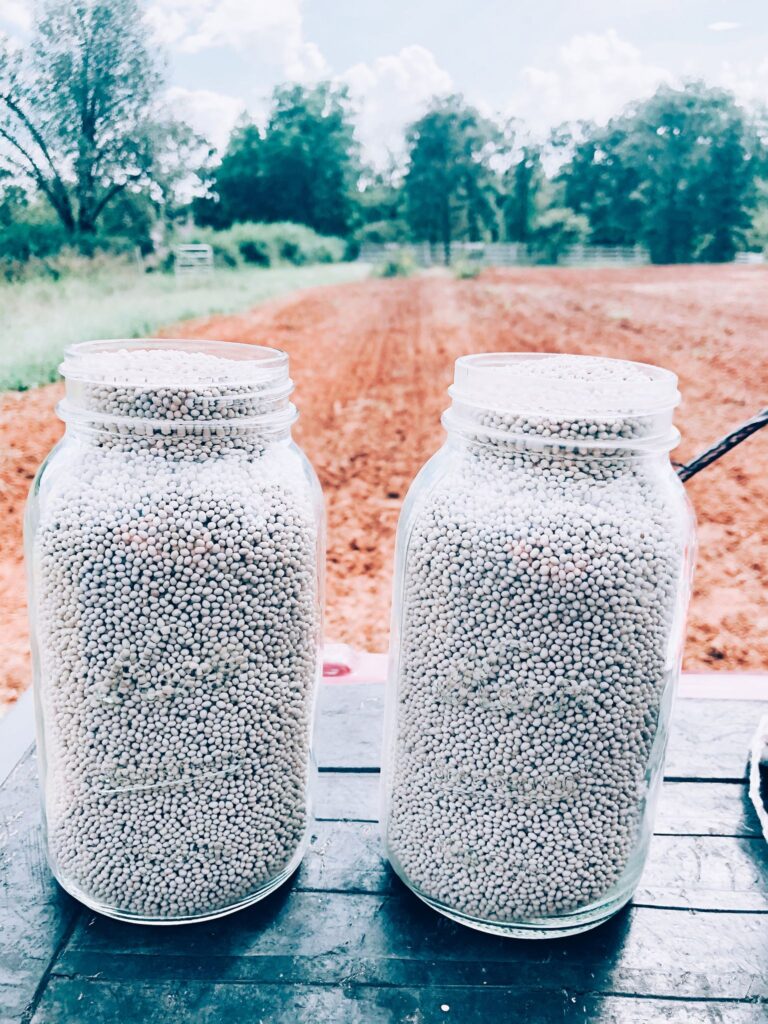A few years ago, Bill asked me to take a walk with him down to the blue barn. He had a surprise for me that he wanted to share. I couldn’t imagine what it might be, but I was more than eager* to join him. Little did I know that he had been planting a field of crimson clover the previous fall. As we turned the corner and approached the barn, I could see a field of red glistening in the sun. It was a field of crimson clover. And, it was glorious.

I shared this story on Instagram @pennypenningtonweeks a couple of springs ago and I remember someone asking me how it was possible that I didn’t notice the clover growing or that Bill had been planting crimson clover. Well, for me it was simple, I grew up in town and had never seen a field of crimson clover. To the unsuspecting (and uninformed) eye, the crimson clover looks like a field of green. Never in a million years would I have guessed that it was a surprise in disguise.
I was also busy taking photos of the deer. Now I know why they were always hanging out in this field.


I will forever think of this first field of clover as a big beautiful bouquet from my husband. That was spring 2019, since then I have learned quite a bit about planting crimson clover. It is such a beautiful cover crop.
*Bill’s version of the story is that I was very reluctant to join him and kept asking why he needed me at the blue barn. His version is probably more accurate—LOL!
But, Why Crimson Clover?
The Basics
Crimson clover is an annual and is considered a cover crop. The first year when Bill was planting the crimson clover, I never thought twice about him being out in the field, sowing seed, or hanging out on the tractor nor did I think to ask what he was doing. And once it popped up, it just looked like a field of green until one day in the spring when it did not. That was the day we went for a walk and I was blown away by a sea of red flowers.

Since that first surprise, I have been excited to help with the annual sowing of the crop. After all, who doesn’t love a little time on the tractor!
Crimson Clover Seed
We purchase our seed from the local feed store and prefer a seed that is coated so that it’s not quite so small which makes it easier to broadcast. You can do the same or order your seed online. The amount needed will depend upon if you are drilling the seed or broadcasting the seed. It will also depend upon if you are seeding alone or as a mixture. The USDA recommends 10-15 pounds of seed per acre when seeding alone.

Sowing Crimson Clover
We sow our crimson clover in late summer or early fall and use a fertilizer spreader to broadcast the seed. We also use the tractor to prepare the field and then drag a harrow over the newly broadcast seed (this is my favorite step to lend a helping hand). To determine when to sow your seed, you need to first determine your first average frost date. You will need to sow your seed 6-8 weeks before the first average frost date. Crimson clover enjoys well-drained soil and often does well in poor quality soil.

I now recognize the field of green that pops up each fall and so do the deer and turkeys that frequent our property. The wildlife absolutely love the crimson clover and it has been great fun to watch them each evening this fall as they snack on the new growth. You may be wondering if the wildlife grazing on the crop destroys it. The answer is no, prior to blooming the crop can be grazed and will continue to grow. During the cold months of winter, the clover will go dormant. The real fun starts in late April or early May when the field becomes a sea of red and blooms until early June. I think the deep dark red florets are spectacular.
Benefits
Beyond the amazing field of beautiful rosettes, crimson clover serves as a great cover crop. Crimson clover is a legume. Legumes are used as cover crops because of their ability to add nitrogen to the soil. In short, crimson clover is great for the soil. We specifically use the crop to help prevent erosion and as a soil builder. Crimson Clover is also often described as a nutrient scavenger. The description is fitting as the roots reach deep into the soil and bring nutrients to the upper soil layers. The clover’s dense canopy also suppresses weeds, a gardener’s worst enemy (that and squash bugs-ugh!).
And if these benefits aren’t enough, both bees and beneficial insects are crimson clover fans.

Other Cover Crops
Crimson clover can be mixed with other cover crops. Bill is most likely to mix our clover with oats or turnips. We also use oats to over-winter our raised beds. As a note, you might want to check with the other gardeners in the family to see what they have already planted or are planning before broadcasting your cover crops. Last fall, I was working on our fall garden—a little spinach, arugula and kale—but all that popped up was oats. Bill was a few steps ahead of me and had already claimed the beds with cover crops. My future salad greens never had a chance.

Don’t get me wrong, I love how the oats look each fall. I am a fan of color and the bright, soft green blades are a welcome sight as the summer garden winds down. The oats are great for the soil and help to reenergize the soil. Like clover, oats help to prevent erosion, add nitrogen and control weeds. The oats will continue to add great color to our fields and gardens until they succumb to the first freeze.
Regarding the turnips, I am not a fan. I know this isn’t fair since turnips deserve lots of accolades as a cover crop. The problem is they sometimes end up in what would otherwise be a fabulous stew prepared by my husband (aka Bill). And unbeknownst to me, my dinner is ruined when I bite into what I assume is a potato. And then I remember, the cover crop (meant for the deer) has made it into the kitchen. Yuk!
My vote is to stick with the beautiful red blooms of Crimson Clover, and maybe a few oats for the chickens (and the soil).



I love this story so much! Bill is the sweetest! I’ve never seen crimson clover in real life but I do know a song about it! 🤣🤣🤣
I love that song! So perfect!
Beautiful and beneficial! Checking all the boxes! Will keep this one in mind for a cover crop!
Thank you so much! I love crimson clover, it is such an amazing cover crop and beautiful at the same time. So worth trying!
-Penny
We have never grown a cover crop, but if it helps the soil and decreases the squash bugs, I am all for it!
Loving your blog!
Thanks so much! I appreciate your kind comment. It’s such a great crop cover and definitely improves the soil.
Thanks but if it attracts deer – I’ll have to definitely pass unfortunately. But looks great in your field.
It definitely attracts deer. It’s a trade off, we love the color and its great for the soil.
What do you do when the flowers fade? I planted mine for show, in the front yard.
We don’t do anything to the crimson clover once it fades. Our is planted in a field and eventually dies back. We replant each fall.
Thank you for the vivid descriptions, reminding me of this clover’s aesthetics in addition to its function. I find that this specific shade of red feeds my soul.
I’m looking to plant Crimson Clover as a cover crop in north Shoshone Idaho. When is the best date to plant Organic Crimson Clover. Any recommendations? Thanks
Check with your local extension office if you need gardening zone information. It will help you determine planting dates.